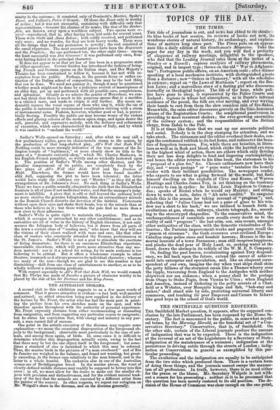THE AUSTRALIAN DIORAMA.
A second visit to this exhibition suggests to us a few more words of comment. That it proves attractive is evident—a fact both well-merited and natural; an added attraction being now supplied in the delivery of the lecture by Mr. Prout, the artist who has had the main part in paint- ing the picture from his own sketches made on the spot, and who therefore speaks throughout with the authority of personal experience. Mr. Prout expressly abstains from either recommending or dissuading from emigration, and from suggesting any particular course to emigrants; but he states his conviction that, with energy and industry in any pur- suit, a man cannot fail of success.
One point in the artistic execution of the diorama may require some explanation—we mean the occasional disproportion of the foreground ob- jects to the background ; observable more particularly in the case of ani- mals, and among these again, of birds. In some cases it is difficult to determine whether this disproportion actually exists, owing to the fact that there may be but the one object itself in the foreground; but some- times a standard of size is furnished to which this may be referred. Thus, the marine birds in the pictures of " a man overboard" and of Rio de Janeiro are weighed in the balance, and found not wanting, but great- ly exceeding, in the former case relatively to the man himself, and in the latter to a whole boatful. The cockatoos also in one of the Australian scenes are of Brobdignagian breed. In the marine pieces, the want of clearly-defined middle distance may readily be supposed to betray into this error; in all, we must allow for the desire to make out the smaller ob- jects with precision and distinctiveness, and for the evident natural tend- ency of the fact that the animals are executed by a different artist from the painter of the scenery. In other respects, we repeat our eulogium on Kr. Weigalris share in the diorama, and on the diorama generally.


























 Previous page
Previous page